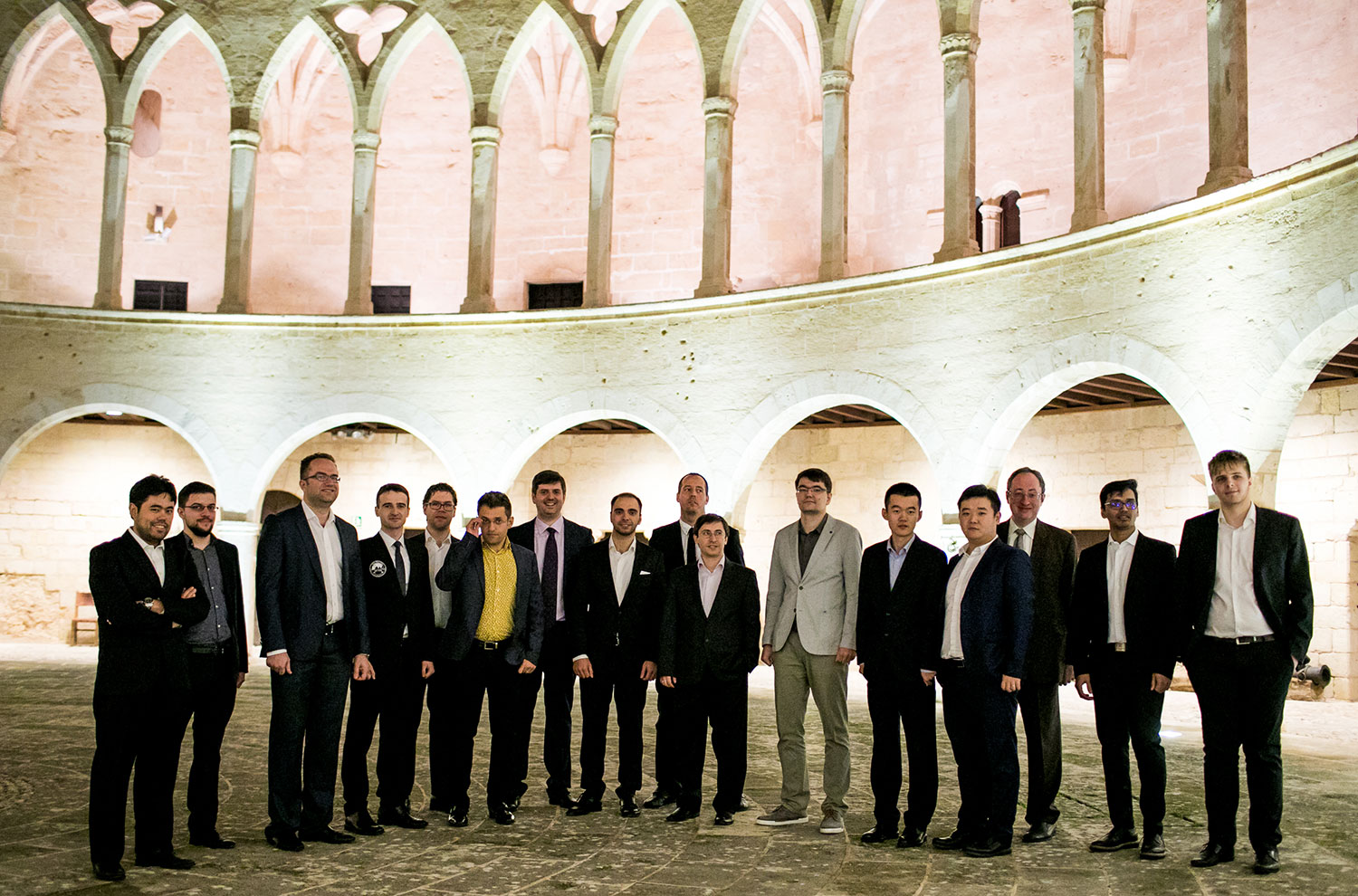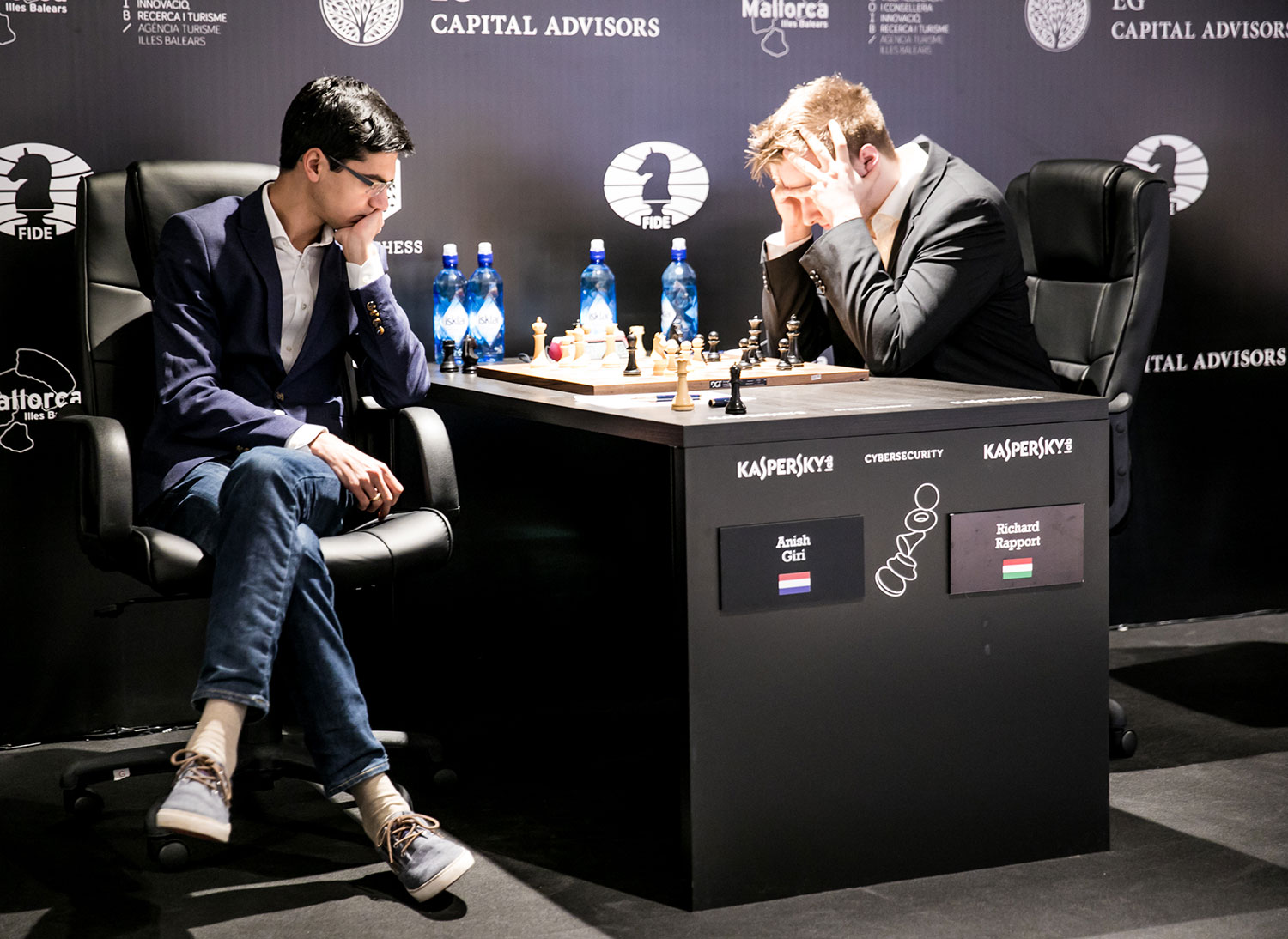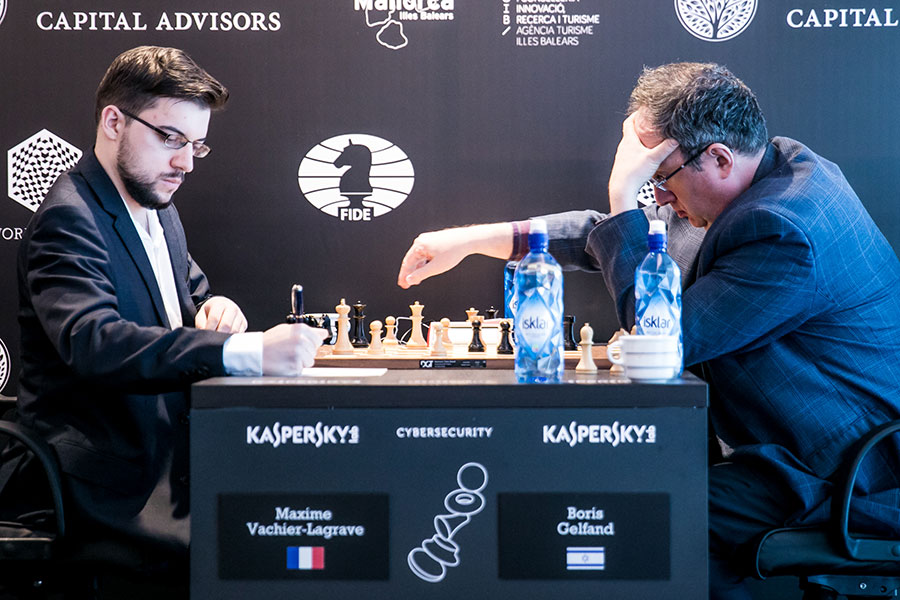The capitol city of the Balearic Islands in the Mediterranean off the Spanish Coast has hosted many great chess tournaments in the past. A traditional tournament was held there every year in the late 1960's, and the 1970 Interzonal saw a great triumph by R.J. Fischer on his way to the World Championship title.
This year Palma de Mallorca is hosting the fourth and final stage of the 2017 FIDE Grand Prix series. 18 grandmasters will contest a nine-round Swiss tournament, but only two of them have a whole lot to play for.

The 18 players who will play in Palma | Photo: Agon

As Spain's number one player, Francisco Vallejo Pons is understadnably the center of the local Spanish media | Photo: Agon
As seen from the Grand Prix standings below, the two leaders in the race for the two remaining spots in the Candidates are both done with their participation. There are three guys still in contention, each of whom can overtake the leaders (or just Grischuk) with a good result in this final tournament. The thing is, Ding Liren no longer needs a qualification spot thanks to his second place finish in the World Cup, which leaves only Teimour Radjabov and Maxime Vachier-Lagrave in the race.
| |
Player |
Sharjah |
Moscow |
Geneva |
Palma |
Total |
| 1 |
Shakhriyar Mamedyarov (AZE) |
140 |
140 |
60 |
|
340 |
| 2 |
Alexander Grischuk (RUS) |
140 |
71 3/7 |
125 |
|
336 3/7 |
| 3 |
Teimour Radjabov (AZE) |
|
71 3/7 |
170 |
|
241 3/7 |
| 4 |
Ding Liren (CHN) |
70 |
170 |
|
|
240 |
| 5 |
Maxime Vachier-Lagrave (FRA) |
140 |
71 3/7 |
|
|
211 3/7 |

Two players who do not need the qualification spots: Ding Liren and Levon Aronian, both of whom earned their spots in the Candidates from the World Cup | Photo: AGON
What do those two need to do? Let's look once again at the Grand Prix regulations and the prize and point distribution.
| Place |
Single Grand Prix event |
Grand Prix points |
| 1 |
€20,000 |
170 |
| 2 |
€15,000 |
140 |
| 3 |
€12,000 |
110 |
| 4 |
€11,000 |
90 |
| 5 |
€10,000 |
80 |
| 6 |
€9,000 |
70 |
| 7 |
€8,000 |
60 |
| 8 |
€7,000 |
50 |
| 9 |
€6,000 |
40 |
| 10 |
€5,000 |
30 |
| 11 |
€4,250 |
20 |
| 12 |
€4,000 |
10 |
| 13 |
€3,750 |
8 |
| 14 |
€3,500 |
6 |
| 15 |
€3,250 |
4 |
| 16 |
€3,000 |
3 |
| 17 |
€2,750 |
2 |
| 18 |
€2,500 |
1 |
We can see now that Radjabov, who needs 95.1 points to finish ahead of Grischuk, would, for example, be just fine with finishing in a three way tie for third place, as that would give him 93.33 points. However, a four-way tie of equal 3-6 would only nets 87.25 points, which would leave Teimour out. This is how fickle it can get: one more guy wins in the last round, catches up with the 3rd place finishers, and that's it, someone else goes to Berlin for the Candidates.
Vachier-Lagrave needs to do even better than that. With a shared 2nd-3rd Maxime would get 125 points, exactly matching Grischuk's total tally. In this case tiebreak criteria would decide. And the first two tiebreaks are:
- Number of actual game result points scored in the three tournaments entered
- Number of games played with black
Perhaps, it could be useful to analyze the final standings of the previous three stages to get some kind of idea what score would be needed for Teimour and Maxime. 6.0/9 won it outright twice, in Moscow and Geneva, while Sharjah saw a three way tie for first with 5.5. I'll dare a guess, that 5.5/9 should be enough for Radjabov, but the same score may not write MVL's ticket.
Anyway, we'll be juggling those numbers as the tournament goes along. For now let's see how it started. There were six draws in the opening round, some of which were quite uneventful.
It's understandable that Ding Liren took his first game rather easy. Let's not forget that Ding just barely made it to Palma in time, as he was busy in St. Louis until Tuesday night. I do, however, believe that despite the absence of qualification concerns this is a very important event for the Chinese player who suddenly finds himself in a dire need of redemption in the aftermath of the horrible beat-down he received at the hands of Magnus Carlsen.
Radjabov made a very short draw today with White against the second-lowest rated player in the tournament. Clearly, Teimour intends to stay on the side of caution, at least for as long as the tournament situation allows it.

After his game, Maxime Vachier-Lagrave is interviewed by Anastasia Karlovich | Photo: Agon
Vachier-Lagrave is another story, It goes without saying that the 2017 Sinquefield Cup Champion is not going to hold back in Palma. Maxime will play every game to win. He got off a great start winning rather easily against Boris Gelfand.

[Event "FIDE Grand Prix Palma 2017"] [Site "Palma de Mallorca"] [Date "2017.11.16"] [Round "1"] [White "Vachier Lagrave, Maxime"] [Black "Gelfand, Boris"] [Result "1-0"] [ECO "B35"] [WhiteElo "2796"] [BlackElo "2719"] [Annotator "Alex Yermolinsky"] [PlyCount "67"] [EventDate "2017.??.??"] 1. e4 c5 2. Nf3 Nc6 {Normally Gelfand goes for the Najdorf.} 3. Nc3 {I guess, Maxime didn't want to enter the Sveshnikov.} g6 {Now it is the Accelerated Dragon without a possibility of the Maroczy Bind, which is helpful for Black.} 4. d4 cxd4 5. Nxd4 Bg7 6. Be3 Nf6 7. Bc4 ({In case of} 7. f3 O-O 8. Qd2 { Black gets to demonstrate his main idea:} d5 $1 {can be played in one go, living up to the name of the opening by accelerating Black's play.}) 7... O-O 8. Bb3 ({Contrary to popular opinion,} 8. f3 Qb6 9. Bb3 Nxe4 {doesn't win for Black} ({Some prefer another knight jump} 9... Ng4 {but the endgame after} 10. fxg4 Bxd4 11. Bxd4 Qxd4 12. Qxd4 Nxd4 13. Nd5 Nc6 14. O-O-O {is rather easy for White to handle.}) {White continues} 10. Nd5 Qa5+ 11. c3 Bxd4 ({Somewhat more reliable is} 11... Nc5 12. Nxc6 dxc6 13. Nxe7+ Kh8 14. Nxc8 Raxc8 15. O-O $11 {Fischer-Panno, 1958.}) 12. Bxd4 Nc5 13. Bc4 Ne6 14. Be3 {with obvious compensation in Baramidze-Motylev, 2003.}) 8... d5 {This is Gelfand's favorite line lately.} ({Usually Black is content with} 8... d6 9. f3 Bd7 10. Qd2 Nxd4 11. Bxd4 b5 {[#] Having messed up White's move order earlier with the help of his Accelerated Dragon trickery Black now accomplishes the b7-b5 advance, something he doesn't normally get in the regular Dragon, where the white bishop stays on c4 until Black plays his rook to c8. As the result, White cannot focus his efforts on a standard procedure of the Yugoslav Attack (as Fischer described it: blast the h-file open, sac, sac and mate), because he is distracted by the threat to his Bb3. Nevertheless, Maxime Vachier-Lagrave is among the high level Grandmasters who have given this position their attention. } {His latest, effort, however, didn't go very well. MVL-Giri, 2017 saw} 12. a4 ({Other options are} 12. h4 a5 13. a4 bxa4 14. Nxa4 h5 15. Nb6 Ra6 16. Nxd7 Nxd7 {Vachier Lagrave-Radjabov, 2017}) ({and} 12. O-O a5 13. a3 $5 { Christiansen-Shabalov, US Championship 2011}) 12... b4 13. Nd5 Nxd5 14. Bxg7 Kxg7 15. exd5 Qb6 16. h4 h5 17. O-O-O Qa5 18. g4 Bxa4 19. Kb1 Bxb3 20. cxb3 Rh8 $1 {Anish was able to parry the attack while retaining his extra pawn. Clearly, White should have thrown in Qd4+ a move or two earlier. I figure MVL doesn't mind giving this line another try.}) ({Of course, there also are} 8... a5) ({ and} 8... Qa5) 9. exd5 Na5 {[#]} 10. O-O ({The combatants weren't strangers to this position, as their previous encounter went} 10. Qd2 Nxb3 11. Nxb3 b5 12. Nxb5 Qxd5 13. Qxd5 Nxd5 14. Bd4 Rb8 {must have been Boris' improvement} ({over } 14... Nb4 {in Giri-Gelfand, played earlier in the same tournament}) 15. Bxg7 Kxg7 16. Na3 (16. Nxa7 Nb4 17. O-O Ba6 18. Rfc1 Rb7 19. a3 Nd3 20. cxd3 Rxb3 $14) 16... Nb4 17. O-O-O $5 Nxa2+ 18. Kb1 Nb4 19. Rhe1 Re8 {MVL-Gelfand, Moscow Grand Prix 2017.}) ({Interesting is} 10. Qf3 Nxb3 11. axb3 Bg4 12. Qg3 Bh5 13. d6 {Karjakin-Dubov, 2015, Ponomariov-Gelfand, 2016, and, most recently, Wei Yi - Li Chao, 2017.}) 10... Nxb3 11. Nxb3 b6 12. d6 $1 {The most practical decision.} ({An attempt to keep the extra pawn with} 12. Qd2 Bb7 13. Rad1 { allows Black too much activity:} Qc7 14. Bf4 Qc4 15. Rfe1 Rfd8 {Negi-Hou Yifan, 2015}) 12... e6 $6 {In turn, Black refuses an offer of a free pawn. I'm not sure I'm too excited with this choice, though.} (12... Qxd6 13. Qxd6 exd6 14. Rfe1 Bf5 15. Nd4 Bd7 16. h3 $14 {Oparin-Gelfand, 2016}) 13. Qf3 Rb8 14. Rfd1 $5 {The first independent move in the game. The idea of leaving the other rook on the Q-side is going to be revealed a few moves later.} ({Naturally, Maxime was familiar with} 14. Rad1 Bb7 15. Qh3 Nd5 16. Nxd5 Bxd5 17. Bd4 Bxd4 18. Rxd4 Rc8 $1 19. Qh6 Qf6 20. Rc1 (20. c3 $142 Rfd8 21. Rfd1) 20... b5 21. Rh4 Qg7 { and Black held his own in Adhiban-Gelfand(!), Isle of Man 2017}) 14... Bb7 15. Qh3 Rc8 16. Bd4 Nd5 17. Nxd5 Bxd5 18. Bxg7 Kxg7 19. Rac1 $1 {[#] White would love to get c2-c4 in. In the meantime, Black is struggling to capture the d6-pawn due to tactical reasons.} b5 20. Qg3 Qf6 21. Nd4 b4 22. c4 bxc3 $2 ({ For sure,} 22... Rxc4 {was a better choice. White would get to keep the d-pawn after} 23. Rxc4 Bxc4 24. d7 Bd5 25. Qd6 Rd8 {but it's not clear how he makes further progress, as the direct} 26. Nc6 Bxc6 27. Qxc6 Qxb2 28. Qc7 Qf6 29. Qxa7 Qc3 30. g3 b3 {leaves him with too little material left for conversion.}) 23. Rxc3 Rxc3 ({The relatively better option,} 23... Rb8 24. b3 Rfd8 25. Rc7 $16 {isn't too attractive either.}) 24. bxc3 Rd8 25. h4 $5 (25. Nb3 {should be good enough as well.}) 25... e5 26. Nf5+ Qxf5 27. Rxd5 Qe4 ({The engine's recommendation to play} 27... Qf4 28. Qxf4 exf4 29. c4 $18 {speaks volumes about the hopelessness of Gelfand's position.}) 28. c4 f6 29. Qc3 Qb1+ 30. Kh2 Qxa2 31. Rd2 Qa4 32. g3 Qc6 33. c5 Rd7 34. Qc4 {Gelfand's resignation was by no means premature} ({as seen from} 34. Qc4 a5 35. Qe6 a4 36. Qxd7+ Qxd7 37. c6 Qxc6 38. d7) 1-0
I don't know if I'm qualified to question Boris Gelfand's opening choices, but this whole line seems depressing. Black gives a pawn and tries to make a draw, how much fun is that? MVL has demonstrated his willingness to take the smallest of advantages out of his Anti-Berlin and Marshall lines and work it into full points. Today he got the position he expected to see, and cashed in without a hitch.
The Accelerated Dragon is much more than just a dynamic yet solid means of countering 1.e4. By knowing how to counter the Maroczy Bind Black can counter both the English and Reti Openings and even develop the basis of a defence against 1.d4.
Whilst having been used extensively by superstars such as Bent Larsen and Tigran Petrosian, Davies argues that the Accelerated Dragon is an even more effective proposition for club players. As he explains on this DVD, many White players are under the mistaken impression that the positions are like a regular Sicilian Dragon. And if this is the case they can find himself being demolished right out of the opening.

Li Chao was definitely not as his best (understatement of the year), and did not offer much resistance to Ernesto Inarkiev. The Russian did wrap it up in style though. | Photo: Agon
Li Chao showed that it was possible to play worse that Gelfand did today. His treatment of the Grunfeld was plain atrocious. I can imagine a quizzical look on Peter Svidler's face as he must have stopped once or twice to take a look at that game.

[Event "FIDE Grand Prix Palma 2017"] [Site "Palma de Mallorca"] [Date "2017.11.16"] [Round "1"] [White "Inarkiev, Ernesto"] [Black "Li, Chao b"] [Result "1-0"] [ECO "D85"] [WhiteElo "2683"] [BlackElo "2741"] [Annotator "Alex Yermolinsky"] [PlyCount "57"] [EventDate "2017.??.??"] 1. d4 Nf6 2. c4 g6 3. Nc3 d5 4. cxd5 Nxd5 5. e4 Nxc3 6. bxc3 Bg7 7. Qa4+ Nd7 ({ Personally, I have always preferred} 7... Qd7 8. Qb3 O-O 9. Nf3 c5 {but recent developments after a new (to me) move} 10. d5 {leave me worried. For example,} e6 11. Be3 exd5 12. exd5 b6 {and here} 13. Bb5 $5 {was Nakamura-Vachier Lagrave, Chess.com Blitz 2016. I wonder what's going on after} Bxc3+ 14. Kd1 ( 14. Ke2 $4 Qxb5+ 15. Qxb5 Ba6 $19) 14... Bxa1 15. Bxd7 Nxd7 {isn't Black supposed to be more than OK here?}) 8. Nf3 O-O 9. Be2 Nb6 $6 {I know I'm not supposed to treat a 2740 player like a schoolboy, but has Li Chao ever heard the famous Dr. Tarrasch dictum "Nb6 always stands badly"?} ({Databases contain hundreds of games with a standard} 9... c5 {and White's results show not more than a normal few percentage points edge.}) 10. Qb4 Qd6 11. O-O Bg4 $6 { What is the point of parting with a bishop when Black isn't attacking d4? More questions that only Li Chao can answer.} (11... Qxb4 12. cxb4 Bg4 {would make more sense.}) 12. Qb3 $1 c6 $6 {To me, an old Grunfeld hand, this move always signifies Black's failure to follow through on this great opening's ideas.} ({ No matter what} 12... c5 13. Ba3 Qc6 {had to be tried.}) 13. Rd1 Qc7 14. Ba3 Nc8 15. Rac1 Bxf3 16. Bxf3 Rd8 {[#] Just like that White has obtained a sizeable advantage without breaking a drop of sweat.} 17. e5 $1 e6 18. c4 Rb8 19. Be4 c5 $6 {A desperate attempt to break out that is doomed to fail.} 20. Bxc5 f6 21. Bb4 (21. Qh3 {also looked mighty good}) 21... fxe5 22. d5 $1 b6 23. dxe6 Ne7 {[#]Now the simple, yet elegant finish.} 24. Rd7 $1 Rxd7 25. exd7 Qxd7 26. c5+ Kh8 27. c6 Rc8 28. Qf7 Qd4 29. Bxe7 1-0
Not the most difficult day in the office for Ernesto Inarkiev, but he gets credit for a smooth game.
The Gruenfeld Defense is an active and dynamic reply to 1.d4 which can lead to complex and extremely sharp positions. So it’s no wonder that also Alexei Shirov included this opening into his repertoire. At the candidates’ final against Vladimir Kramnik in Cazorla in 1998, he exclusively – and successfully – trusted the Gruenfeld Indian with Black; the victory over Kramnik gave him the right to play a WCh match versus Kasparov.
Another winner today was Anish Giri, who had to work hard to overcome the ever-resourceful Richard Rapport. What I like the most about this game was the finish.

[Event "FIDE Grand Prix Palma 2017"] [Site "Palma de Mallorca"] [Date "2017.11.16"] [Round "1"] [White "Giri, Anish"] [Black "Rapport, Richard"] [Result "1-0"] [ECO "E12"] [WhiteElo "2762"] [BlackElo "2692"] [Annotator "Alex Yermolinsky"] [SetUp "1"] [FEN "5k2/8/6p1/2p5/P5P1/P2Q2NP/K2n4/3q4 w - - 0 45"] [PlyCount "35"] [EventDate "2017.??.??"] {There were many ways to skin that cat, but Giri found the prettiest solution. } 45. Ne4 $1 Nxe4 46. Qxd1 Nc3+ 47. Kb3 ({Even} 47. Ka1 Nxd1 48. a5 Nc3 49. a6 Nb5 50. a4 Na7 51. h4 $1 {is a win, illustrating how useless a knight can be when it comes to dealing with rook pawns.}) 47... Nxd1 48. a5 Ne3 49. a6 c4+ 50. Kc3 Nd5+ 51. Kxc4 Nc7 52. a7 g5 {An important move.} 53. Kc5 Ke7 54. Kc6 Na8 {[#] It may seem that Black may survive, but it's only an illusion.} 55. Kd5 $1 (55. Kb7 $2 Kd7 $11 56. Kxa8 $4 Kc7 {and White loses! After he runs out of the second a-pawn moves, he would have to commit suicide with h3-h4.}) 55... Kf6 56. Kd6 Kf7 57. Ke5 Kg6 58. Ke6 Nb6 59. a4 Na8 60. a5 {This little soldier plays his part by taking away the b5-square.} Kg7 {Black was in Zugzwang} ({as } 60... Nc7+ {gives White a key tempo in the kings race to the Q-side.} 61. Kd7 ) 61. Kf5 Kh6 62. Kf6 {Nice!} 1-0
Anish is working on fixing some issues that plagued his game in the past couple of years. I think he will fight hard to win his confidence back, along with a few rating points.

Anish Giri chose the prettiest way to win, and certainly gets brownie points for the effort | Photo: Agon
I think it would be wrong to suspect the players with no qualification tasks to address would just go through the motions. They are proud individuals who always try their best, so let's not write this tournament off as an afterthought in the 2017 calendar. If anything, I expect to see very interesting chess played in Palma!
All games (Round 1)
Links











